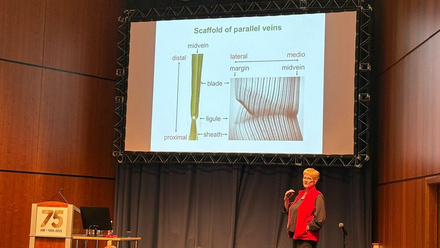JXB Volume 72, Issue 18 – Editor’s choice
JXB Volume 72, Issue 18 – Editor’s choice
This article highlights the following publication:
Transcriptional, hormonal, and metabolic changes in susceptible grape berries under powdery mildew infection
Diana Pimentel, Rute Amaro, Alexander Erban, Nuria Mauri, Flávio Soares, Cecília Rego, José M Martínez-Zapater, Axel Mithöfer, Joachim Kopka, Ana Margarida Fortes
Journal of Experimental Botany, Volume 72, Issue 18, 30 September 2021, Pages 6544–6569, https://doi.org/10.1093/jxb/erab258
Wine drinkers’ worst enemy: Powdery mildew infection in grape
A sommelier’s ornate vocabulary is sprinkled with bloomy metaphors. Wine can have an earthy or grassy nose, its bouquet reminiscent of forest floor and leaves, combined with an herbaceous or oaky finish. Whereas slangy descriptions such as “foxy”, “meaty”, “cheesy”, and “toasty” speak of a high quality yet reveal nothing about the wine’s ingredients, “musty” tasting wine is oftentimes literally just that: prepared from mouldy grapes and, unfortunately, oftentimes destined for the sink. Fungal infection is a widespread phenomenon in the worldwide most cultivated grape species Vitis vinifera with powdery mildew caused by the fungus Erysiphe necator being one of the most problematic diseases in terms of prevalence and economic loss. Both yield and wine quality can be severely compromised since infected leaves have lower photosynthetic capacity and diseased berries grow smaller and can develop undesirable off-flavours.
Most grape varieties have little genetic resistance against E. necator. Frequent prophylactic fungicide application is thus standard treatment in viticulture despite the well-known side-effects, namely toxicological risk for ecosystems, beneficial organisms, and human health, as well as development of fungicide-resistance in fungal populations. Climate change is likely to exacerbate the problem by creating more favourable growth conditions for fungi. However, increased consumer demand for environmentally friendly products and tougher restrictions imposed by regulatory authorities such as the European Commission necessitate reduced fungicide usage. It is thus critical to profoundly understand the biological mechanisms of plant-pathogen interaction against this disease that is common also in other major cash crops including cereals and fruit trees. New insight into fungal infection strategies and plant defence responses may give rise to transferable knowledge for more sustainable management strategies.
Erysiphe necator infects all chlorophyll containing tissue in grape and research has thus focused on powdery mildew in leaves. However, young green grape berries are also highly susceptible. At the onset of véraison, the developmental transition from berry growth to berry ripening, increasing resistance is observed in some grape varieties yet certain cultivars remain susceptible until full véraison. This ontogenic, age-related resistance is not fully understood especially in grape berries.
In this issue of the Journal of Experimental Botany Pimentel et al. (2021) present transcriptional, hormonal, and metabolic changes in berries of the red wine grape Carignan infected with powdery mildew. Samples were collected during the highly susceptible late green period and two weeks later when berries began changing their colour to better understand the tolerance development. Their results are an intriguing example of the complicated interplay and molecular arms race between host plants and their pathogens.
In general, pathogen resistance is divided into two distinct forms. Immunity responses can be evoked by so-called pathogen associated molecular patterns (PAMPs), among others the fungal cell wall component chitin. Chitin is detected by plant membrane receptors that initiate intracellular responses such as secretion of antimicrobial compounds. However, powdery mildew can release effector molecules that suppress the PAMP-triggered immunity (PTI) and thereby induce susceptibility. Certain plants have acquired effector-triggered immunity (ETI) in which resistance proteins (R proteins) detect and effectively respond to effectors with, for example, programmed cell death to prevent fungal spread.
Pimentel et al. (2021) found indicators for both these layers of defence in infected Carignan berries. The first barrier pathogens face when infecting plant tissues is the cuticle, a waxy surface layer that may have antimicrobial effects. In contrast to leaves, the results in berries show increasing levels of long chain saturated fatty acids most likely due to changes in cuticle composition, suggesting organ-specific defence responses. Furthermore, pattern recognition receptors and signalling factors coordinating the intracellular response were up-regulated and defence-associated metabolites such as phenylpropanoids were increased. Induction of these defence mechanisms were, however, insufficient to restrict fungal infection and berries remained susceptible also during the onset of véraison. The authors speculate that activation of certain susceptibility genes known to be essential for successful penetration of E. necator might be contributing factors to the prolonged susceptibility.
Powdery mildew is an obligate biotroph fungus meaning that it derives its nutrients from living host tissue. This plant-pathogen feeding relationship is reflected in the data as well. Sugar metabolism in grapes was found to be reprogrammed, and detection of fungal transcripts involved in carbohydrate uptake and metabolism indicate that plant sugars were at least partially directed towards fungal consumption. Likewise, host and pathogen genes related to transport of nitrogen were upregulated, suggesting transfer of this growth-promoting macronutrient between host and fungus.
Pimentel et al.’s comprehensive multi-omics dataset provides new insight into the complex infection-induced changes in primary and secondary berry metabolism. Importantly, several metabolites have been identified that can serve as biomarkers for early-stage diagnosis in the field to improve phytosanitary treatments and better contain this fungus that threatens the global multi-billion-dollar grape business.
 Clusters of Vitis vinifera cultivar Carignan grapes naturally infected with powdery mildew (Erysiphe necator, visual symptoms indicated with arrows) at late green stage (A) and early véraison (B) when berries started to change colour (Pimentel et al., 2021).
Clusters of Vitis vinifera cultivar Carignan grapes naturally infected with powdery mildew (Erysiphe necator, visual symptoms indicated with arrows) at late green stage (A) and early véraison (B) when berries started to change colour (Pimentel et al., 2021).





